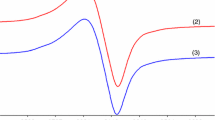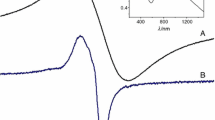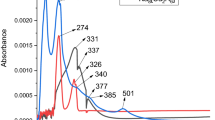Abstract
New complexes of type [Cu(HTBG)2]Cl2 (1), [Cu(TBG)2]·3H2O (2) and [CuL]·nH2O (3) L:L1, n = 2 and (4) L:L2, n = 1 (HTBG: 2-tolylbiguanide, L1 and L2: ligands resulted from 2-tolylbiguanide, ammonia/hydrazine and formaldehyde one pot condensation) were synthesised and characterised. The features of complexes have been assigned from microanalytical, IR and UV–Vis data. Redox behaviour was established by cyclic voltammetry. The in vitro qualitative and quantitative antimicrobial activity assays showed that the complexes exhibited variable antimicrobial activity against Gram-negative and Gram-positive strains isolated from the hospital environment. The thermal analyses have evidenced the thermal intervals of stability and also the thermodynamic effects that accompany them. After water elimination, complexes have a similar thermal behaviour. Processes as water elimination, melting, chloride anion removal as well as oxidative degradation of the organic ligands were observed. The final product of decomposition was copper (II) oxide.








Similar content being viewed by others
References
Bertini I, Grey HB, Stiefel EI, Valentine JS. Biological Inorganic Chemistry. Structure and reactivity. Sausalito, Califonia: University Science Books; 2007. p. 95.
Nomiya K, Yoshizawa A, Kasuga NC, Yokoyama H, Hirakawa S. Synthesis, solid-state characterization and antimicrobial activities of three different polymorphs of a copper(II) complex with 4-isopropyltropolone (hinokitiol). Inorg Chim Acta. 2004;357:1168–76.
Miodragović DU, Bogdanović GA, Miodragović ZM, Radulović M-D, Novaković SB, Kaluderović GN, et al. Interesting coordination abilities of antiulcer drug famotidine and antimicrobial activity of drug and its cobalt(III) complex. J Inorg Biochem. 2006;100:1568–74.
El-Ayaan U, El-Metwally NM, Youssef MM, El Bialy SAA. Perchlorate mixed–ligand copper(II) complexes of beta-diketone and ethylene diamine derivatives: thermal, spectroscopic and biochemical studies. Spectrochim Acta A. 2007;68:1278–86.
Singh K, Singh Barwa M, Tyagi P. Synthesis and characterization of cobalt(II), nickel(II), copper(II) and zinc(II) complexes with Schiff base derived from 4-amino-3-mercapto-6-methyl-5-oxo-1,2,4-triazine. Eur J Med Chem. 2007;42:394–402.
Efthimiadou EK, Katsaros N, Karaliota A, Psomas G. Mononuclear copper(II) complexes with quinolones and nitrogen-donor heterocyclic ligands: synthesis, characterization, biological activity and interaction with DNA. Inorg Chim Acta. 2007;360:4093–102.
Sathisha MP, Shetti UN, Revankar VK, Pai KSR. Synthesis and antitumor studies on novel Co(II), Ni(II) and Cu(II) metal complexes of bis(3-acetylcoumarin)thiocarbohydrazone. Eur J Med Chem. 2008;43:2338–47.
Gudasi KB, Patil MS, Vadavi RS. Synthesis, characterization of copper(II), cobalt(II), nickel(II), zinc(II) and cadmium(II) complexes of [7-hydroxy-4-methyl-8-coumarinyl]glycine and a comparitive study of their microbial activities. Eur J Med Chem. 2008;43:2436–41.
Efthimiadou EK, Katsarou ME, Karaliota A, Psomas G. Copper(II) complexes with sparfloxacin and nitrogen-donor heterocyclic ligands: structure–activity relationship. J Inorg Biochem. 2008;102:910–20.
Wang T, Guo Z. Copper in medicine: homeostasis, chelation therapy and antitumor drug design. Curr Med Chem. 2006;13:525–37.
Louie AY, Meade TJ. Metal complexes as enzyme inhibitors. Chem Rev. 1999;99:2711–34.
Fricker SP. Metal based drugs: from serendipity to design. Dalton Trans 2007:4903–17.
Thompson KH, Orvig C. Metal complexes in medicinal chemistry: new vistas and challenges in drug design. Dalton Trans 2006:761–4.
Olar R, Badea M, Lazar V, Balotescu C, Cristurean E, Marinescu D. Thermal behaviour of some N,N-dimethylbiguanide derivatives displaying antimicrobial activity. J Therm Anal Calorim. 2007;88:323–7.
Olar R, Badea M, Cristurean E, Lazar V, Cernat R, Balotescu C. Thermal behavior spectroscopic and biological characterization of cobalt(II), zinc(II), palladium(II) and platinum(II) complexes with N,N-dimethylbiguanide. J Therm Anal Calorim. 2005;80:451–5.
Olar R, Badea M, Grecu MN, Marinescu D, Lazar V, Balotescu C. Thermal behavior, spectroscopic and biological characterization of copper(II) complexes with N,N-dimethylbiguanide. J Therm Anal Calorim. 2008;92:239–43.
Balotescu M-C, Oprea E, Petrache L-M, Bleotu C, Lazar V. Antibacterial, antifungal and cytotoxic activity of Salvia officinalis essential oi land tinctures, Roum. Biotech Lett. 2005;10:2471–9.
Babykutty PV, Prabhakaran CP, Anantaraman R, Nair CGR. Electronic and infrared spectra of biguanide complexes of the 3d-transition metals. J Inorg Nucl Chem. 1974;36:3685–8.
Nakamoto K. Infrared and Raman spectra of inorganic and coordination compounds. New York: Wiley; 1986. p. 228–9.
Lever ABP. Inorganic electronic spectroscopy. Amsterdam: Elsevier; 1986. p. 554.
Zanello P. Inorganic electrochemistry: theory, practice and application. Cambridge, UK: Royal Society of Chemistry; 2003. p. 302–313.
Modi CK, Patel MN. Synthetic, spectroscopic and thermal aspects of some heterochelates. J Therm Anal Calorim. 2008;94:247–55.
Abou El-Enein SA. Polymeric and sandwich Schiff’s bases complexes derived from 4,4′-methylenedianiline. Characterization and thermal investigation. J Therm Anal Calorim. 2008;91:929–36.
Gaber M, Rehab AF, Badr-Eldeen DF. Spectral and thermal studies of new Co(II) and Ni(II) hexaaza and octaaza macrocyclic complexes. J Therm Anal Calorim. 2008;91:957–62.
Vikram L, Sivasankar BN. Hydrazinium metal(II) and metal(III) ethylenediamine tetraacetate hydrates. Spectral, thermal and XRD studies. J Therm Anal Calorim. 2008;91:963–70.
Author information
Authors and Affiliations
Corresponding author
Rights and permissions
About this article
Cite this article
Olar, R., Badea, M., Marinescu, D. et al. Thermal, spectral and antimicrobial study on some Cu(II) complexes with ligands bearing biguanide moieties. J Therm Anal Calorim 99, 815–821 (2010). https://doi.org/10.1007/s10973-009-0414-8
Received:
Accepted:
Published:
Issue Date:
DOI: https://doi.org/10.1007/s10973-009-0414-8




